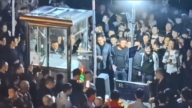【新唐人2012年2月6日讯】去年12月四川社科院向中西部14个省市区发出倡议,联合对中共红军的所谓“长征路线”进行申遗。有学者指出,所谓“长征”,事实上是中共红军遭国民政府第五次围剿失利之后的“逃窜”,但两年中超过一万公里的逃窜史,却被中共党史学家编写成了“长征”史。现在中共当局倡议“申遗”,无非是为了宣传它的政权合法性,而地方官员则利用“申遗”搞政绩和捞钱。
四川社科院和中西部14个省市区将共同推进申遗、建立长征文化馆等工程。
中共号称的二万五千里“长征”,途经江西、四川、重庆和陕西等十五省、市及自治区。
香港《东方日报》认为,四川的倡议不过是为了搞政绩。报导引述网民的留言说,申遗是政绩、建馆是形象、扶贫是圈钱,几全其美的事,难怪其他地方响应。
中国历史学专家、原“首都师范大学教育科学学院”副教授李元华则指出,所谓“长征”,事实上是中共红军遭国民政府第五次围剿失利之后的“逃窜”,但两年中超过一万公里的逃窜史,却被中共党史学家编写成了一段可歌可泣的“长征”史。
中国历史学专家李元华:“他们(官员)本身不是看重“长征”有多么伟大,而是想借此名义来扩大本地区的知名度,或以此为由去开发新的一条旅游线路,赚取更多的钱。从这个角度来讲他们可能都会卖命的去做。”
网络上,网友们对“长征申遗”嘲讽与骂声一片。
四川民主人士冉云飞在微博上说:“这和皇帝逃窜四川说成“幸蜀”一样,纯属欺罔和意识形态洗脑。”
大陆律师梁刚则说:“逃跑都可以申遗,能进2012年十大笑话。”
大陆自由撰稿人、原河北人民广播电台编辑朱欣欣则表示,所谓“长征”路线,并不具备文化遗产的条件。
大陆自由撰稿人朱欣欣:“它(长征)可能在中共它们自己的党文化历史中,有很重要的意义或者是一个很重要的事件。但如果放在全世界人类历史上来考察这件事情,它完全不具备世界文化遗产这种性质和条件。搞这种倡议倡导,无非就是为中共所谓的合法性进行宣传。”
早在去年,大陆历史学家高华已经指出:“从1936年开始,中共要求写红军‘长征’的回忆,直接起因很现实,就是争取外国人对红军的物质援助。但最后,由回忆录100多篇结集而成的《红军长征记》,却长期作为‘党内参考资料’禁止流出。”
1954年中宣部将这本书改为《中国工农红军第一方面军长征记》内部发行,但删除了描写红军吃喝玩乐的文章,因为文章的描述与中共宣传的红军每天冒着枪林弹雨,被迫吃草根、啃树皮充饥的叙述不符。
李元华表示,中共对“长征”的叙述,是按照它的政治需要而不断进行歪曲编造,如今倡议申遗,只是执政合法性危机下的需要而已。
新唐人记者刘惠、李明飞、萧宇采访报导。
The Long March: Intangible Cultural Heritage or CCP’s Propaganda?
Last December, Sichuan Academy of Social Sciences invited
14 central and western provinces and municipalities
to jointly apply for cultural heritage of the so-called
Red Army Long March route.
Some scholars indicated that the so-called Long March is
in fact the history of the escape route of the
Chinese Communist Red Army after the Fifth defeat by
the Nationalist Government.
This escape covers more than 10,000 km in two years.
The Communist historians made it into history of the Long March.
The application for a cultural heritage is believed to serve
as nothing but promotion of the legitimacy of the CCP,
and a tool for local officials to publicize their performance
while profiting.
Sichuan Academy of Social Sciences and 14 provinces and
municipalities in western China will work together
to promote the World Heritage List and projects
such as the Long March cultural centers.
Known as the Chinese Communists’ 25,000 km, the Long March route
covers 15 provinces, municipalities and autonomous regions such as Jiangxi, Sichuan, Chongqing and Shaanxi.
Hong Kong’s Oriental Daily News believes Sichuan’s initiative
is solely a political performance.
According to the report, netizens believe the heritage application
and construction of cultural centers is a publicity stunt
and the poverty alleviation objective of the project is misappropriating;
but too good for any other local government to turn down.
Chinese history expert, Li Yuanhua, former associate professor
in the School of Education Science, Capital Normal University,
pointed out that the so-called long march is in fact the
Chinese Communist Red Army escape route after being defeated for the Fifth time by the Nationalist Government.
The Communists fled more than 10,000 kilometers in two years.
The Communist Party historians made it into the Long March, a period of epic history.
Chinese historian Li Yuanhua: “They (officials) don’t care
about the importance of the long march,
but use the name for the visibility of the region and
to develop a new tourist route for money making.
From this perspective, they will work for it with their lives."
On the Internet, this heritage project has seen mocking and
condemnation from Web users.
Sichuan democratic activist Ran Yunfei wrote on the microblog,
“This is similar to when the emperor fled to Sichuan but was said to have “visited Sichuan.”
It’s a purely deceiving and brainwashing ideology.
Mainland lawyer Liang Gang said, “If escaping can be classified
as heritage, it should be on the top ten joke list of 2012.
Freelance writer and former Hebei People’s Radio Editor, Zhu
Xinxin, said that the so-called Long March route does not qualify as cultural heritage.
Freelance writer Zhu Xinxin: “It (the Long March) may be a
very important event of significance to the Communists.
Considering this event in the grand scheme of world history,
it does not have the quality or nature of world cultural heritage.
Such an initiative is only to advocate so-called legitimacy for
the Chinese Communists."
As early as last year, historian Gao Hua pointed out that since
1936, the CCP inquired the memoir of the Red Army’s Long March with
a very realistic and direct purpose – to fight for
material assistance to the Red Army from foreigners.
Finally, the memoir with more than 100 articles has long been
recognized as an inner reference and is prohibited from being revealed.
In 1954 this memoir was changed to “Long March of the First
Red Army" by the Central Propaganda Department and used as internal documents.
The articles describing the entertainment of the Red Army
were deleted because they do not match the propaganda
which describes how the Red Army was forced to eat grass and
chew bark to fill their stomachs while braving a hail of bullets.
Li Yuanhua said that the Chinese Communists have distorted
and fabricated the Long March to accommodate its political needs.
The heritage application is to fulfill its desire during
the current crisis regarding its political legitimacy.
NTD reporters Liu Hui, Li Mingfei and Xiao Yu





























